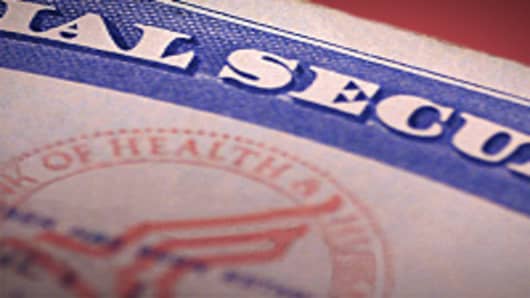Arizona may be the frontline of the immigration policy debate, but states far from the Mexican border are also busy grappling with the issue.
Twenty-two states are considering legislation similar to Arizona’s new immigration law, which, among other things, requires law enforcement officers to check a person's immigration status while enforcing other laws and that immigrants carry legal papers.
In Missouri, for instance, a state law prohibits the issuance of a drivers license to an illegal alien and employers from knowingly hiring or continuing to hire one. The law also penalizes municipalities that become sanctuaries by making them ineligible for state grants.
Utah is considering a guest worker program that some say could become a national model.
In Colorado, former GOP Congressman Tom Tancredo, whose 2008 presidential bid was built around his fervent attention to the problems of illegal immigration, has entered the governor’s race as a third-party candidate.
In California, Republican gubernatorial candidate and former eBay CEO Meg Whitman has a lengthy list of prohibitionsand is recommending the creation of an “economic fence," as well as the completion of the physical one underway along the U.S.-Mexico border.
Her Democratic rival, former governor and current attorney general, Jerry Brown, doesn't single out the issue on his campaign website.
Frontline States
California remains the leading state of residence for illegal aliens; in 2009 it had 2.6 million (6.8 percent of the total population). Texas was a distant second (1.7 million), followed by Florida (720,000), New York (550,000) and Illinois (540,000), according to Department of Homeland Security data. There are an estimated 11-million in all.
Though the immigration debate is louder than ever, the actual number of illegal aliens has slowed in the past two years, according to the Pew Research Center, with some attributing the trend to the recession.
From 2007-2009, it averaged 300,000 per year, from 550,000 in the the 2005-2007 period. During the first half of the decade, it averaged 850,000 a year.
Nevertheless, for states like, California, Texas, New Mexico and Arizona, immigration is an inescapable issue.
A 20-foot high fence separates 646 miles of the 2000-mile border between those US states and Mexico. Half of it is in Arizona. The federal government has spent $2.5 billion building it thus far and is expected to spend another $6.5 billion maintaining it over the next 20 years, according to a US Border Patrol audit.
Some 613,000 foreign nationals; 86 percent of whom were natives of Mexico, were caught trying to enter the country last year, according to the Dept. of Homeland Security, while the number of people apprehended by its Border Patrol unit fell 23 percent from the previous year, continuing a decade-long trend.
Counting The Costs
Prevention and detention, however, are just a fraction of the costs.
A new study by the Federation for American Immigration Reform, FAIR, concludes illegal immigration now costs federal and local taxpayers $113 billion a year.
States and local authorities provide $84.2 billion of it. Arizona’s annual cost, for example, is $2.5 billion, which given its population may be disproportionately high. It happens to be the state with the busiest gateway for illegal immigrants. Tucson, for instance, accounted for 241,667 or 45 percent, of all Mexican border apprehensions last year.
Education for the children of illegal aliens, for instance, totals some $52 billion, according to the study.
That can clearly stretch resources and take its toll.
Between 1970 and 2008, immigrants (legal and illegal) went from 9 percent of California's population to 27 percent, according to a Center for Immigration Studies report.
During that period, the state went from having the 7th-most educated work force (based on the percentage of workers having completed high school) to the 50th.
Limited Federal Action
For all the hue and cry, never mind legislative maneuvering, at the state level, there’s been little, if any action, at the federal level since 2007, when the Bush administration failed to push through its immigration reform plan, which included an amnesty program.
Many expected legislation in 2010, but it now has probably slipped to 2011.
Instead, the Obama administration has been pressed into another kind of action. It is sending 1,200 National Guard troops to the Southwest border states. The Homeland Security Department is also getting $600 million to spend on 1,500 new agents for the Border Patrol, as well as Immigration & Customs and Drug Enforcement agencies.
In July, Pres. Obama called for reform legislation this year in his first major speech on the subject, wherein he described the system “broken.”
More recently Sen. Lindsey Graham (R-S.C.) used the same word to describe the nation’s immigration laws and called on Congress to take up the issue next year.
Graham and New York Democrat Charles Schumer have been working on legislation that would strengthen border security, allow temporary workers and lead to legal residence.
Key to the plan is the institution of a biometric (high-tech, fraud-proof) Social Security card to ensure illegal workers cannot get jobs.
Obama and others have proposed some kind of amnesty program, which would raise tax receipts but also mean government benefits.
Based on data from the 1986 amnesty program, the Center for Immigration Studies estimates that some 3.2 million illegal aliens would qualify for Medicare coverage if they became legal residents at a cost of $8.1 billion a year.
Under such circumstances, the new health care law will eventually add to those costs, given the high number of illegal aliens living below the poverty line.
Legal Immigration
Lost in the debate is the irony that legal immigration has become a problem of its own.
More than 1 million immigrants acquire legal status each year, more than double the number during the 1976-1980 period. The Pew Center estimates that current immigration trends (both legal and illegal) will push the total US population from 306 million in 2009 to 438 million by 2050.
The last commission to study the problem—the Jordan Commission in the 1990s—recommended an annual reduction to 550,000. Others say the rate should be set at a neutral level, where the number of new immigrants is equal to the number leaving the country.
Some studies have concluded that there are clear links between legal and illegal immigration.
According to Homeland Security,almost 165,000 Mexicans obtained legal permanent residence in the U.S. last year, with more than 59,000 of them residing in California. Overall, some 228,000 people from various countries obtained such status in the state.
Either way Californians look at, immigration is a pressing problem. The outcome of the the governor's race may make that clear to Washington.





